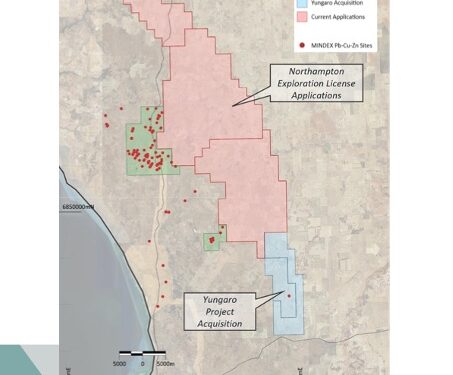Caprice Resources Ltd (ASX: CRS) has significantly expanded its Northampton Project in Western Australia through some strategic acquisitions and licence applications.
The Northhampton Project now measures over 1,170 sq. km via three new Exploration Licence Applications (ELAs) and the purchase of the Yungaro Project 2 via three new Exploration Licence Applications (ELAs) and the purchase of the Yungaro Project.
Caprice has submitted three ELAs which abut the company’s existing 150 sq. km Northampton tenements. The ELAs cover an area of c.900 sq. km.
In addition, the company has agreed to purchase the Yungaro Project from a private party for $210,000 in Caprice scrip plus milestone payments. The Yungaro Project consists of two granted exploration licences covering c.130 sq. km, which abut the southernmost ELA. Combined, the Northampton Project now covers over 1,170 sq. km.
Between 1850 and 1973, over 100 base metals deposits were mined in the Northampton Mineral Field. Production is estimated at 77kt Pb, 4.3kt Cu, 42t Zn and 212kg Ag. Almost all of the deposits outcropped at surface. The deposits are structurally controlled, generally occurring as massive or disseminated sulphides or in breccias.
Since production ceased, the area has seen minimal modern exploration.
RC drilling by Caprice near the Wheal Fortune Mine in late 2020 returned outstanding first pass results of 31m @ 1.1% Cu, 2.0% Pb & 9g/t Ag, incl. 3m @ 3.8% Cu, 3.8% Pb & 3g/t Ag.
Using regional geophysical datasets, Caprice has interpreted early structural corridors away from the historical mining area which may have the potential to host a broader style of structurally controlled hydrothermal Pb-Cu-Zn-Ag mineralisation.
Managing Director, Andrew Muir, said first pass work will likely involve a regional aeromagnetic survey to assist in refining the geological and structural interpretation of the region to generate targets prior to any significant on-ground exploration.
“Via some detailed geological analysis, Caprice has recognised a significant opportunity in the Northampton region,” Mr Muir said.
“The region has had significant historical production, and we believe it remains very fertile, yet it has not been subject to modern exploration methods or the application of new concepts.”
The Pb-Zn-Cu-Ag mineralisation mined in historical deposits was narrow, typically sub-vertical and composed of massive to semi-massive sulphides. Recovered lead ores typically contained greater than 20% Pb from galena dominant lodes.
The larger historical deposits including Narra Tarra, Baderra and Wheal Ellen, recovered ore over a strike length greater than 200m and down to a vertical depth of 100m or more. Historically, lead was the dominant mineral mined, with minor copper and a small number of zinc operations.
Mine plans and reports have referenced copper zones where lead mineralisation gave way to copper dominant mineralisation. As historical mines were targeting lead zones, mining often ceased once the copper rich zone was encountered.
Exploration Strategy
Exploration away from the historical mineralisation has been very limited.
Furthermore, • the stratigraphy, structural geology and intrusive history of the complex is poorly studied, • biased towards the historical lead dominant positions, • primarily focussing on areas with well exposed bedrock geology, and • with a focus Broken Hill style targeting models in more recent decades.
However, the Company believes there remains significant upside around the historical mining areas, with 2020 drilling returning excellent drill results of 31m @ 1.1% Cu, 2.0% Pb and 9g/t.
On a more regional scale, the company is looking to focus exploration on the interaction between the early pre-existing structures and features with the controlling north east striking structures.
For further information please visit: https://www.capriceresources.com/












